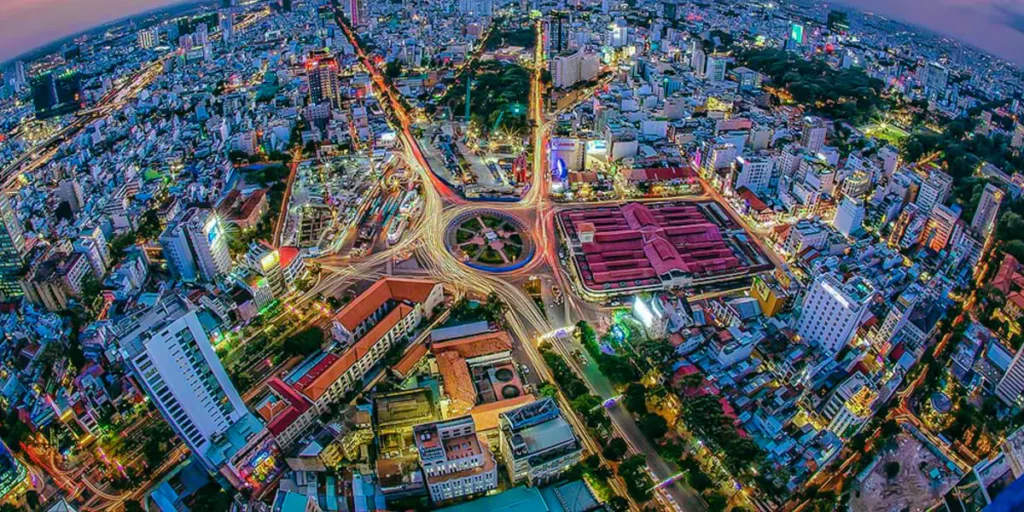Vietnam is rapidly emerging as a dynamic force in the global economy, and the development of its International Financial Centre (IFC) in Ho Chi Minh City (HCMC) marks a pivotal milestone in this journey. Approved by the National Assembly in June 2025, this ambitious project aims to position Vietnam as a competitive regional financial hub, challenging established centers like Singapore and Hong Kong. With a focus on banking, asset management, fintech, green finance, and crypto-assets, the IFC represents a strategic push toward economic modernization, attracting foreign direct investment (FDI), and fostering innovation. For investors and businesses in Singapore and beyond, this development offers exciting opportunities in one of Asia’s fastest-growing markets.
As of September 15, 2025, construction has officially begun on the HCMC IFC, following the effective date of Resolution No. 222/2025/QH15 on September 1, 2025. This resolution provides a legal framework for establishing IFCs in both HCMC and Da Nang, creating a “one center, two destinations” model that leverages the unique strengths of each city. Whether you’re exploring Vietnam IFC investment opportunities or seeking insights into Southeast Asia financial hubs, this guide delves into the project’s details, implications, and potential for regional collaboration.
Historical Context: Vietnam’s Evolution into a Financial Powerhouse
To understand the significance of the Vietnam IFC, it’s essential to trace the country’s financial sector evolution. Vietnam’s economy has transformed dramatically since the Đổi Mới reforms in 1986, shifting from a centrally planned system to a market-oriented one. By the early 2020s, Vietnam had become a manufacturing giant, attracting FDI from tech and electronics firms like Samsung and Intel. However, the financial sector lagged, with shallow capital markets and limited international integration.
The push for an IFC began gaining momentum in the mid-2020s, driven by Vietnam’s ambition to achieve upper-middle-income status by 2030 and high-income by 2045. Key milestones include the 2023 amendments to the Securities Law, which enhanced market transparency, and the 2024 launch of the Vietnam Stock Exchange’s derivatives platform. These reforms laid the groundwork for deeper financial markets, setting the stage for the IFC. Today, with GDP growth averaging 6-7% annually and a tech-savvy population of over 100 million, Vietnam is ripe for financial innovation. The IFC builds on this foundation, aiming to bridge the gap between domestic needs and global standards.
Project Overview and Timeline: From Concept to Reality
The Vietnam IFC operates under a dual-location model: HCMC as the primary hub for traditional finance and Da Nang as a specialized center for emerging sectors. HCMC’s IFC, spanning 783 hectares with a 9.2-hectare core zone in the Thu Thiem New Urban Area, focuses on banking and asset management. Da Nang, meanwhile, will pilot innovative frameworks from 2025 to 2028, emphasizing green finance and crypto-assets before national scaling.
Construction in HCMC kicked off in September 2025, with an estimated completion by late 2025 for initial operations and full build-out over five years. The project’s timeline is outlined in the table below:
| Phase | Timeline | Key Activities |
|---|---|---|
| Planning and Approval | June-July 2025 | National Assembly passes Resolution No. 222/2025/QH15. |
| Legal Framework Activation | September 1, 2025 | Resolution takes effect; draft decree released for consultation. |
| Construction Start | September 2025 | Groundbreaking in Thu Thiem; infrastructure development begins. |
| Pilot Phase (Da Nang) | 2025-2028 | Testing green finance and crypto regulations. |
| Full Operations | Late 2025 onward | Launch of core services; national scaling post-2028. |
This structured approach ensures phased implementation, minimizing risks while building momentum.
Investment and Infrastructure: Building a World-Class Hub
Backed by VND 172 trillion (approximately USD 7 billion), the IFC’s investment underscores Vietnam’s commitment to high-quality infrastructure. The Thu Thiem New Urban Area, a 7-square-kilometer district, will feature modern skyscrapers, smart city technologies, and sustainable designs. Key elements include high-speed rail connections, upgraded Tan Son Nhat International Airport, and digital infrastructure for seamless fintech operations.
Da Nang’s complementary role enhances the ecosystem, with investments in eco-friendly projects like carbon trading platforms and blockchain hubs. This infrastructure not only supports financial activities but also aligns with Vietnam’s digital transformation goals, such as the National Digital Economy Strategy to 2025.
Tax Incentives and Regulatory Reforms: Attracting Global Capital
A cornerstone of the IFC’s appeal is its investor-friendly policies. Effective September 1, 2025, members benefit from a 10% corporate income tax (CIT) rate, exemptions on dividends and capital gains, and streamlined visa processes for foreign experts. These incentives are detailed in the August 2025 draft decree from the Ministry of Finance, which emphasizes compliance with international standards like FATF guidelines.
Regulatory reforms focus on transparency and efficiency, including simplified business registrations and enhanced anti-money laundering measures. For fintech firms, this means easier licensing for digital banking and payment systems, positioning Vietnam as a testing ground for innovations.
Focus Areas: Banking, Fintech, Green Finance, and Crypto-Assets
The IFC’s sectoral emphasis caters to diverse needs:
- Banking and Asset Management: HCMC will host global banks and funds, deepening capital markets with increased liquidity in equities and bonds.
- Fintech: Leveraging Vietnam’s vibrant startup scene (e.g., Momo, VNPAY), the IFC will foster collaborations for AI-driven services and digital wallets.
- Green Finance: Da Nang’s pilot will promote sustainable investments, including green bonds and ESG funds, aligning with Vietnam’s net-zero goals by 2050.
- Crypto-Assets: Regulated frameworks for blockchain and digital currencies will attract crypto investors, with pilots ensuring security and innovation.
Regional Comparison: Vietnam vs. Singapore and Hong Kong
How does the Vietnam IFC stack up against regional leaders? The following table provides a high-level comparison:
| Aspect | Vietnam IFC | Singapore | Hong Kong |
|---|---|---|---|
| Establishment Year | 2025 (operational) | 1960s | 1840s |
| Key Focus | Fintech, Green Finance, Crypto | Wealth Management, FX Trading | Stock Exchange, IPOs |
| Tax Rate | 10% CIT | 17% CIT (incentives available) | 16.5% Profits Tax |
| Cost of Operations | Low (emerging market) | High | High |
| Growth Potential | High (6-7% GDP) | Moderate (2-3% GDP) | Moderate (3-4% GDP) |
| FDI Appeal | Emerging, incentives-driven | Established, stable | Gateway to China |
While Singapore excels in maturity and stability, Vietnam offers cost advantages and rapid growth, making it an attractive complement for diversification.
Economic Impacts: Driving Growth and Job Creation
The IFC is projected to boost Vietnam’s economy by attracting USD 10-15 billion in FDI annually by 2030, creating over 50,000 high-skilled jobs in finance and tech. Domestically, it will enhance market depth, reducing borrowing costs for businesses and supporting SMEs. Regionally, it could reshape Southeast Asia’s financial landscape, fostering cross-border deals and integrations.
Challenges and Risks: Navigating the Path Ahead
Despite optimism, hurdles exist. Regulatory delays, cybersecurity threats, and talent shortages could impede progress. Geopolitical tensions in the South China Sea may affect investor confidence. Mitigation strategies include international partnerships, such as the UK-Vietnam Financial Insights Summit, and robust training programs.
Opportunities for Singapore Investors: Synergies and Deal Flows
For Singapore-based platforms like DealFlow.sg, the Vietnam IFC presents synergies in fintech and green finance. Singapore investors can leverage expertise in wealth management to partner with Vietnamese firms, exploring joint ventures in blockchain or sustainable projects. Lower costs in Vietnam combined with Singapore’s regulatory prowess could drive efficient deal flows.
Future Outlook: Vietnam’s Place in Global Finance
By 2035, the IFC aims to establish Vietnam as a top ASEAN financial hub, with full integration post-Da Nang pilot. Ongoing collaborations, like those with ASEAN partners, will ensure sustained growth.
In conclusion, the Vietnam International Financial Centre is more than infrastructure—it’s a catalyst for transformation. As HCMC and Da Nang integrate, opportunities abound for investors seeking high returns in emerging markets.




